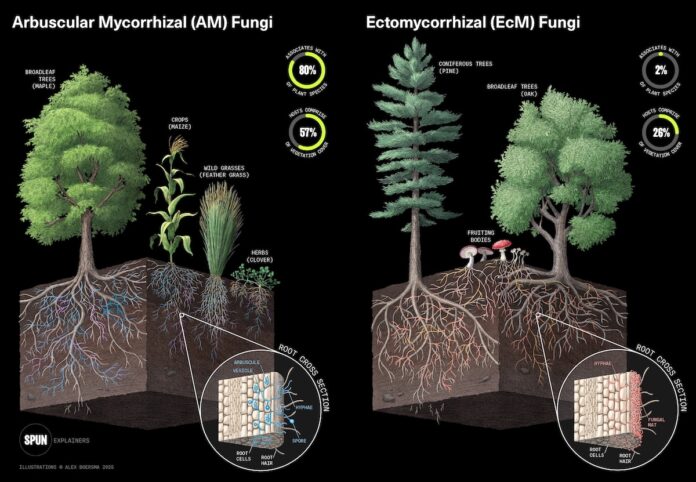"Unearthing the Hidden Heroes: Why Our Underground Fungi Networks Deserve Urgent Conservation"
Urgent Call for Conservation of Underground Fungal Networks
Date: July 25, 2025
Source: Society for the Protection of Underground Networks (SPUN)
In a groundbreaking study, researchers from the Society for the Protection of Underground Networks (SPUN) have highlighted the critical need for conservation efforts aimed at underground fungal networks, which play a vital role in sustaining Earth’s ecosystems. The findings reveal that approximately 90% of mycorrhizal fungi biodiversity hotspots are located in unprotected ecosystems, raising alarms about potential ecological repercussions.
The Role of Mycorrhizal Fungi
Mycorrhizal fungi are essential for nutrient cycling, carbon storage, and plant health. They form symbiotic relationships with plant roots, facilitating nutrient uptake and enhancing soil structure. According to Dr. Toby Kiers, Executive Director of SPUN, these fungi are crucial for forest regeneration and agricultural productivity. “When we disrupt these critical ecosystem engineers, forest regeneration slows, crops fail, and biodiversity above ground begins to unravel,” Kiers stated.
The study emphasizes that these fungi draw over 13 billion tons of carbon into soils annually, which is roughly equivalent to a third of global fossil fuel emissions. However, despite their significant role in climate regulation, mycorrhizal fungi have been largely overlooked in conservation and climate change strategies.
Mapping Biodiversity Hotspots
Utilizing over 2.8 billion fungal sequences from 130 countries, researchers created high-resolution predictive biodiversity maps of underground mycorrhizal communities. This innovative approach marks the first large-scale scientific application of SPUN’s 2021 world mapping initiative. The maps reveal that only 9.5% of fungal biodiversity hotspots are located within existing protected areas, underscoring the urgent need for targeted conservation efforts.
“For centuries, we’ve mapped mountains, forests, and oceans. But these fungi have remained in the dark,” Kiers remarked. “This is the first time we’re able to visualize these biodiversity patterns — and it’s clear we are failing to protect underground ecosystems.”
Implications for Ecosystem Resilience
The loss of mycorrhizal fungi could lead to decreased carbon emissions reduction rates, diminished crop productivity, and reduced ecosystem resilience to climate extremes. The study’s findings, published in the journal Nature, emphasize that safeguarding these underground ecosystems is crucial for food security, water cycles, and climate resilience.
Dr. Michael Van Nuland, lead data scientist at SPUN, stated, “These maps are more than scientific tools — they can help guide the future of conservation.” The research has garnered support from prominent advisors, including conservationist Jane Goodall and authors Paul Hawken and Michael Pollan.
A Global Initiative
SPUN aims to provide resources for policymakers, conservation groups, and researchers to identify biodiversity hotspots and prioritize interventions. The organization is currently collaborating with an international network of 96 “Underground Explorers” from nearly 80 countries, sampling some of the most remote underground ecosystems on Earth, including those in Bhutan, Mongolia, Ukraine, and Pakistan.
Despite only 0.001% of the planet’s surface being sampled, SPUN’s dataset already includes over 40,000 specimens representing 95,000 mycorrhizal fungal taxa. This extensive research highlights the vast potential for discovering unique fungal communities and the urgent need for their protection.
Conclusion
As the world grapples with climate change and biodiversity loss, the findings from SPUN serve as a clarion call for immediate action. The conservation of underground fungal networks is not just an ecological necessity; it is a fundamental component of sustainable environmental management. “These maps reveal what we stand to lose if we fail to protect the underground,” Kiers concluded, emphasizing the importance of integrating underground biodiversity into environmental decision-making.
For more information on SPUN’s initiatives and to access the biodiversity maps, visit SPUN’s official website.
